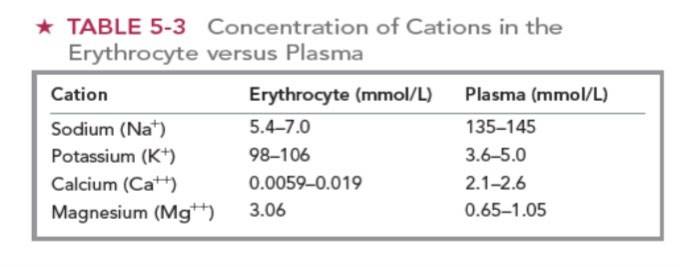Study Set Content:
- Chloride-bicarbonate exchange
- Constitutes 25% of total membrane protein
- Where Chloride shift happen
Band 3 (Anion Exchange Protein 1)
- Chloride is Negative and Bicarbonate is positive in charge
Select the Correct Answer:
when RBC moves into tissues, there will exchange in gases. RBC will release oxygen and will accept carbon dioxide. Some of the CO2 will be carried by RBC and some will be in the plasma
Select the Correct Answer:
CO2 makes the body basic
Select the Correct Answer:
cause of increase in CO2
Hypoventilation
If CO2 is abundant, the RBC will only take CO2 and will react to the water in the ICF, and due to enzymatic process with the help of carbonic anhydrase that could form the carbonic acid. Carbonic acid will further broken down forming Bicarbonate and Hydrogen ions. Bicarbonate is negative charge and will be released by the RBC and neutralize the increase of the acidity brought by the increase in CO2 in the body. this is an example of negative feedback mechanism.
Select the Correct Answer:
The RBC will not meet its electron neutrality
Select the Correct Answer:
the Chloride in the plasma will be taken inside the cell to compensate the loss of bicarbonate
chloride shift
- Major protein
- Predominant skeletal protein, it exists as a heterodimer of two large chain
- Biconcave disc shape of RBC
- Unfold and refold
Spectrin
spectrin refolds in narrow passages
Select the Correct Answer:
Unfolding (extend, stretching or deformation) occurs if the RBC goes into narrow passages (capillaries)
Select the Correct Answer:
If RBC is normal, the spectrin coil
Select the Correct Answer:
Actin forms a short filaments of 14-16 monomers whose length is regulated by
tropomyosin and tropomodulin
sites of attachment
Ankyrin spectrin 4.1, 4.2 spectrin, and adducin (makes the peripheral protein stable due to the binding in integral protein)
- Critical to RBC survival as the cell travels through the microvasculature. Also essential for oxygen delivery.
- Proteins require ATP.
- Loss of ATP (energy) levels leads to decrease in the phosphorylation of spectrin, and, in turn, to a loss of membrane deformability. Also leads to an accumulation of membrane calcium causing an increase in membrane rigidity and loss of pliability
Membrane deformability
a type of poikilocyte which is not deformable due to the decrease in surface area and damage in proteins Caused by:
o Thermal injury
o Intrinsic Abnormalities
o Immune Hemolysis
Spherocyte
- Caused by thermal injury
- Resulting to blebbing or vesicle formation of RBC membrane and it will decrease the surface area leading to a small size of RBC
- Also caused by the antibodies attachment, when macrophages sense it through their Fc portion they will engulf the portion leaving the RBC in smaller size.
Microspherocyte
- Caused by intrinsic abnormalities
- Genetic mutation causing microvesicle formation
Hereditary Spherocyte
RBC has the ability to close again due to the spectrin that is why it doesn't create holes to avoid the cytoplasmic leakage
Select the Correct Answer:
- Red cell membrane is freely permeable to water (aquaporin 1) and to anions (band 3)
- Na+/K+ cation pump and Ca++ ATPase pump

Membrane Permeability
